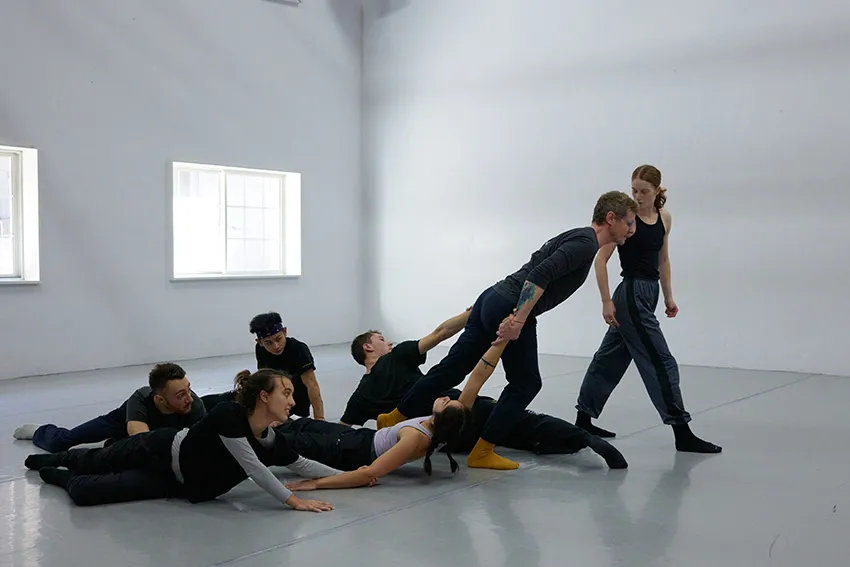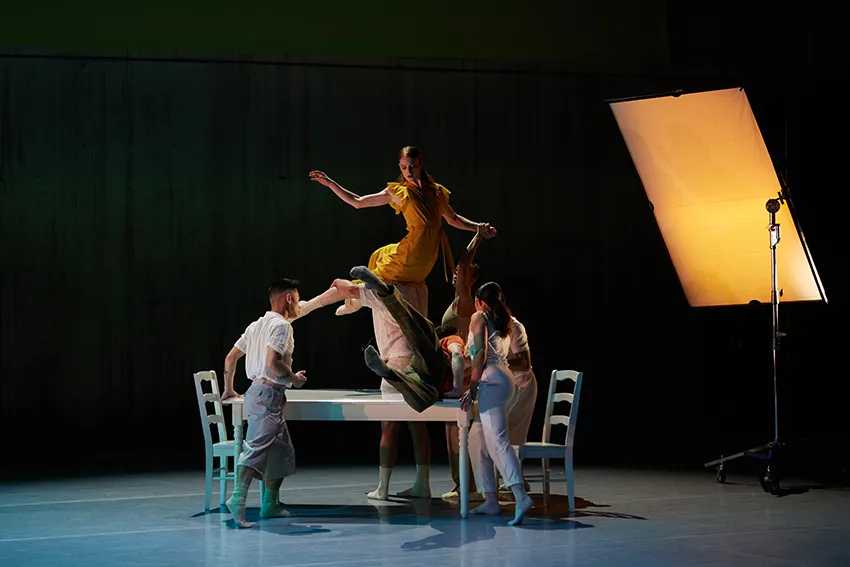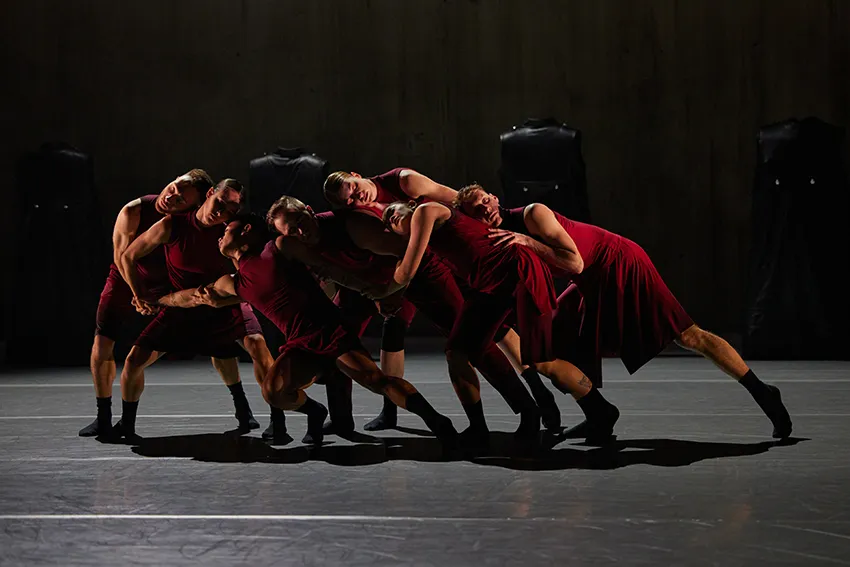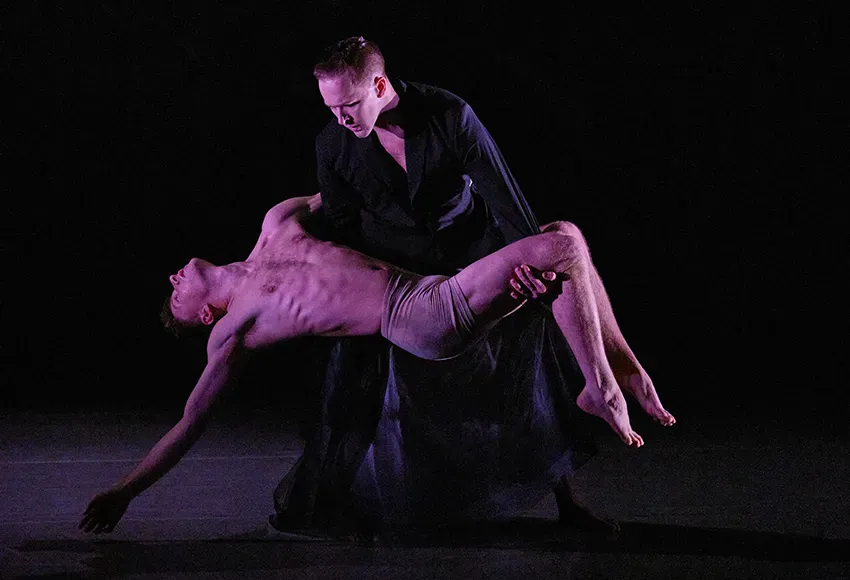WHIM W'HIM SEATTLE CONTEMPORARY DANCE
NEW CREATIONS 23
Cornish Playhouse
January 20, 2023
Seven is a magic number for Olivier Wevers. His Whim W'Him Seattle Contemporary Dance Company, founded in 2009, has always consisted of seven dancers – no more, no less. The individuals have changed from season to season, but the company always engages seven immensely gifted dancers to present new works to their delighted and faithful audiences.
But why have seven dancers, instead of six, or ten? Why not add or subtract dancers depending on the project? The stability of Whim W'Him over its first 14 years suggests that the size of the troupe is one of the elements that make the company viable. (Whim W'Him has just purchased the former All Saints Church on Queen Anne Hill as its company home and future dance school, a wonderful achievement that demonstrates Wevers' financial savvy and the loyal support he's earned for his company over the years.)
On the other hand, there must be artistic reasons for the asymmetry of an odd-numbered, manageably sized troupe. Having seven dancers to work with challenges choreographers to think about that extra, seventh person. Are they the odd person out? Could that extra dancer be the straw that tips the balance of a group into a mob, or that pixilates a sun into a constellation? If you have seven people, they can scatter into seven different directions or clot into an amoeba, a river, a chorus line.
Over the years, Wevers has offered 40 choreographers – including himself – the opportunity to work out ideas using the magic number of seven dancers. That's enough people to make a big impact, but not so many as to be overwhelming to newer choreographers, who are beginning to develop ideas that use more dancers than themselves and their two best friends.

Wevers is, of course, the top choreographer among the 40, having made (by my count) 32 new works for the company. He started Whim W'Him to give himself the opportunity to develop his love of dance making, as well as to give other choreographers a chance to add to their repertoires. He's brought a rich variety to Seattle to create works for his magnificent seven – from the well known, like Annabelle Lopez Ochoa and Penny Saunders, to up-and-coming talents who win the privilege of creating a new work by submitting videos for the annual "Choreographer's Shindig."
Over the years, a unique body of work has been developed for Whim W'Him that demonstrates how seven dancers can inspire a range of work, from the moody to the quirky to the fabulous and grand. Three intriguing new works for the company repertoire were premiered at Cornish Playhouse last week.
A Lavender Touch
Choreography: Olivier Wevers
Music: Jacque Morali, Henry Percell, Safvk
The opening work of the evening combined Purcell's famous lament from the English opera Dido and Aeneus with the recorded voice of Harvey Milk – the first Gay person to be elected to the San Francisco Board of Supervisors and one of the first homosexuals to be elected to public office in the United States. He was assassinated in 1978 for his courageous advocacy of Gay rights.
Of the many striking elements in this narrative dance, there were three that stood out for me: a male dancer in a long tulle skirt – a kind of spirit of compassion or suffering – who haunted each sequence of the dance, following the trials of Gay people as they were ridiculed, beaten up, and victimized; a nightclub scene where men and women danced under a disco ball to a tune very much like "YMCA" – a joyous moment ruined by police and persecution, illustrated by a group somersault that turns into a single figure pulling the inert group like a heavy chain (in my notes I wrote "AIDS?"); and the most compelling of all, a finale in which the focal character is persecuted and killed, but then embraced by the spirit – and then in one tantalizing moment takes on the pose of Michelangelo's Pietà.
Wevers' heartbreaking dance conjures up – for those of us old enough to remember these events in real time – a terrible, irrational period of violent persecution, when Gay men and women stopped apologizing for being Gay. As Harvey Milk said, "Society belongs to all people in society. Equality is what America is all about."

primetime
Choreography, music, costumes: Mike Esperanza
I'm old enough to recognize the references to the fight for Gay justice in the 1970s, but too old to recognize the TV shows that frame Esperanza's dance about primetime television. The set looks like a family home populated by two camps: the couple who really live in the house, and shadow people dressed in white who imitate the couple as if they were filming a TV show based on the real people.
No matter: I didn't need the references to enjoy the dance. The two worlds were clearly established, compelling the viewer to consider the difference between the "real" world of the young couple and the imitative, robotic world of the film crew/shadow people – which was taking place in a theater full of real people in the audience and real people on stage pretending to be either real or ghostly.
This world of nesting dolls has a lot to say about the intersections between reality and the fantasies of reality. It was unsettling, especially since the couple in the dance weren't the happiest people in town. Esperanza's real/unreal world was a clever narrative dance and a tour de force from the mind of a multitalented choreographic world-builder.

Yemaya's Embrace
Choreography: Annabelle Lopez Ochoa
Original composition: Jimmy Garver
The last dance of the evening was by a company favorite, Annabelle Lopez Ochoa, who has made eight dances for Whim W'Him. This one surely must be the most striking of all.
In it, Lopez Ochoa uses seven large metal forms that look like body-length military vests. At first they're lined up along the back of the stage, unnoticed, while the seven dancers roll back and forth along the ground like so many logs buffeted by waves in the ocean. The perfectly coordinated back-and-forth rolling conveys a powerful image of the sea – a kind of freedom in conformity.
At key moments, some of the dancers sneak onto the coat form, sticking a head out the armhole, an arm out the neckhole. When the dancers are in these contraptions they can only move with tiny steps – a metaphor for the tortuous constraints imposed on citizens of totalitarian states.
Yemayá is the goddess of the ocean in the Santería religion and sacred to practitioners of that faith in Cuba and Mexico, where, in the case of the former, a totalitarian government is surrounded by the beauty and freedom of the sea. The rigidity of the metal jackets contrasts with the freedom and lightness of the dancers as they represent the free-flowing sea. Through a series of undulating sequences, contrasted with the sheer weirdness of the looming jackets, the viewer becomes aware of the mournful loss of freedom in totalitarian countries that remember happier times.
The flow of immigrants around the world, fleeing from domination by those who impose the personal and political restraints that the jackets imply, is beautifully represented in this dance. I found the gestures and coordination of the dancers in Lopez Ochoa's choreography to be the most beautiful of the evening. I didn't have to know exactly which country was being represented by the rigidity of the metal forms, since Lopez Ochoa so clearly exposed the consequences of such restraints, paid for with isolation, starvation, and displacement.
All in all, it was a wonderful – and wonderfully thought-provoking – evening of dance, soundscapes, and imagery. To think that so much can be accomplished on stage by only seven dancers is one of the wonders of Whim W'Him that makes this company so successful and so unique.


